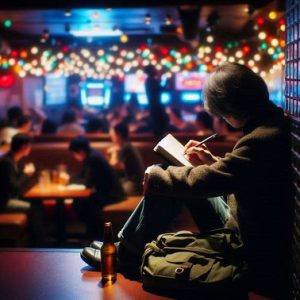Stories Written in Neon: Capturing Jeju Room Salon Culture Through Literature
 Nightlife across the globe offers a vibrant tapestry of human experience, a stage where countless dramas unfold under the cloak of darkness and artificial light. For centuries, authors have found inspiration in the after-hours world, using bustling pubs, smoky jazz clubs, and clandestine speakeasies as compelling backdrops for their narratives. These settings provide a unique lens through which to explore themes of ambition, despair, love, and loneliness. The inherent anonymity and heightened emotions often present in nightlife venues create fertile ground for character development and plot twists, drawing readers into worlds both familiar and extraordinary.
Nightlife across the globe offers a vibrant tapestry of human experience, a stage where countless dramas unfold under the cloak of darkness and artificial light. For centuries, authors have found inspiration in the after-hours world, using bustling pubs, smoky jazz clubs, and clandestine speakeasies as compelling backdrops for their narratives. These settings provide a unique lens through which to explore themes of ambition, despair, love, and loneliness. The inherent anonymity and heightened emotions often present in nightlife venues create fertile ground for character development and plot twists, drawing readers into worlds both familiar and extraordinary.
Jeju Island, renowned for its breathtaking natural beauty and tranquil landscapes, also possesses a less-explored, yet equally captivating, nocturnal pulse. Beyond the serene beaches and volcanic craters, a different kind of energy thrives in its karaoke bars, lounges, and private rooms, venues often referred to as a Jeju Room Salon (제주룸싸롱). These establishments, far from being mere places of entertainment, are microcosms of social interaction, negotiation, and fleeting connections. They represent a fascinating cultural space that, when approached with a discerning literary eye, can unlock a wealth of storytelling potential. Imagine the hushed conversations, the clinking glasses, the melodies of a melancholic song, each element a potential thread in a rich narrative tapestry.
The Allure of the Liminal Space
Literary power often stems from exploring liminal spaces, those in-between places where societal norms can blur, and identities can be reshaped, even temporarily. Nightlife venues embody this concept perfectly. A karaoke bar on Jeju is not just a place to sing; it is a stage where inhibitions are shed, where aspirations are voiced (sometimes loudly, off-key), and where vulnerabilities are exposed.
These environments naturally lend themselves to dramatic tension. Who is the quiet businessman nursing a drink in the corner? What secrets do the hostesses exchange between songs?
The very atmosphere of these places, charged with expectation and often a sense of fleeting escape, can inspire complex characters and intricate plots.
Consider the myriad of characters one might encounter: a struggling artist seeking inspiration, a weary traveler looking for solace, a local grappling with the pressures of tradition and modernity, or a group of friends celebrating a milestone. Each person carries a story, and the unique, often intimate, setting of a room salon allows these stories to intertwine in unexpected ways. The blend of vibrant sounds, dim lighting, and often elaborate décor creates a sensory-rich environment that can be vividly translated onto the page, immersing readers directly into the heart of the narrative.
Crafting Narratives from Reality
Writers have a unique ability to weave together threads of reality and imagination, transforming observations into compelling fiction. For those looking to set their stories within Jeju’s nightlife, blending factual elements with fictional narratives is key. Researching the customs, etiquette, and social dynamics of these venues can provide a solid foundation.
Understanding the roles of hosts and hostesses, the types of clientele, and the unspoken rules of engagement adds authenticity to the storytelling.
However, it’s the imaginative leap, the creation of memorable characters and unforeseen circumstances, that truly brings these settings to life.
Authors can draw inspiration from the diverse array of human emotions on display. Joy, sorrow, camaraderie, rivalry, all these feelings are amplified in the enclosed, often intense, environment of a private room. A single glance, a hushed whisper, a shared laugh over a forgotten lyric, these small moments can serve as catalysts for entire plotlines. Think of the potential for a mystery novel unfolding amidst the karaoke melodies, or a poignant romance blossoming over shared drinks, or even a psychological thriller exploring the darker undercurrents that can sometimes exist beneath the veneer of entertainment.
The Cultural Tapestry of Jeju’s Nightlife
Exploring Jeju’s nightlife through literature offers more than just intriguing settings; it provides a valuable opportunity to delve into the island’s unique cultural fabric. These venues are not isolated entities but are deeply integrated into the social landscape, reflecting broader societal trends and individual aspirations.
A story set in a local room salon can offer insights into Korean hospitality, the nuances of social hierarchy, and the evolving identities of both locals and visitors on this special island.
The contrast between Jeju’s serene natural beauty during the day and its bustling, often boisterous, nightlife creates a compelling duality that writers can exploit for thematic depth.
Literary works set in such specific cultural contexts also serve as windows for readers worldwide, offering a glimpse into lives and experiences that might otherwise remain unseen. By fictionalizing the experiences within Jeju’s karaoke bars and lounges, writers can contribute to a richer understanding of Korean society and the universal human need for connection, celebration, and sometimes, simply an escape from the everyday. The stories written in neon, within the vibrant walls of a Jeju Room Salon, have the power to resonate deeply, revealing the complex beauty of human interaction under the glow of a disco ball.